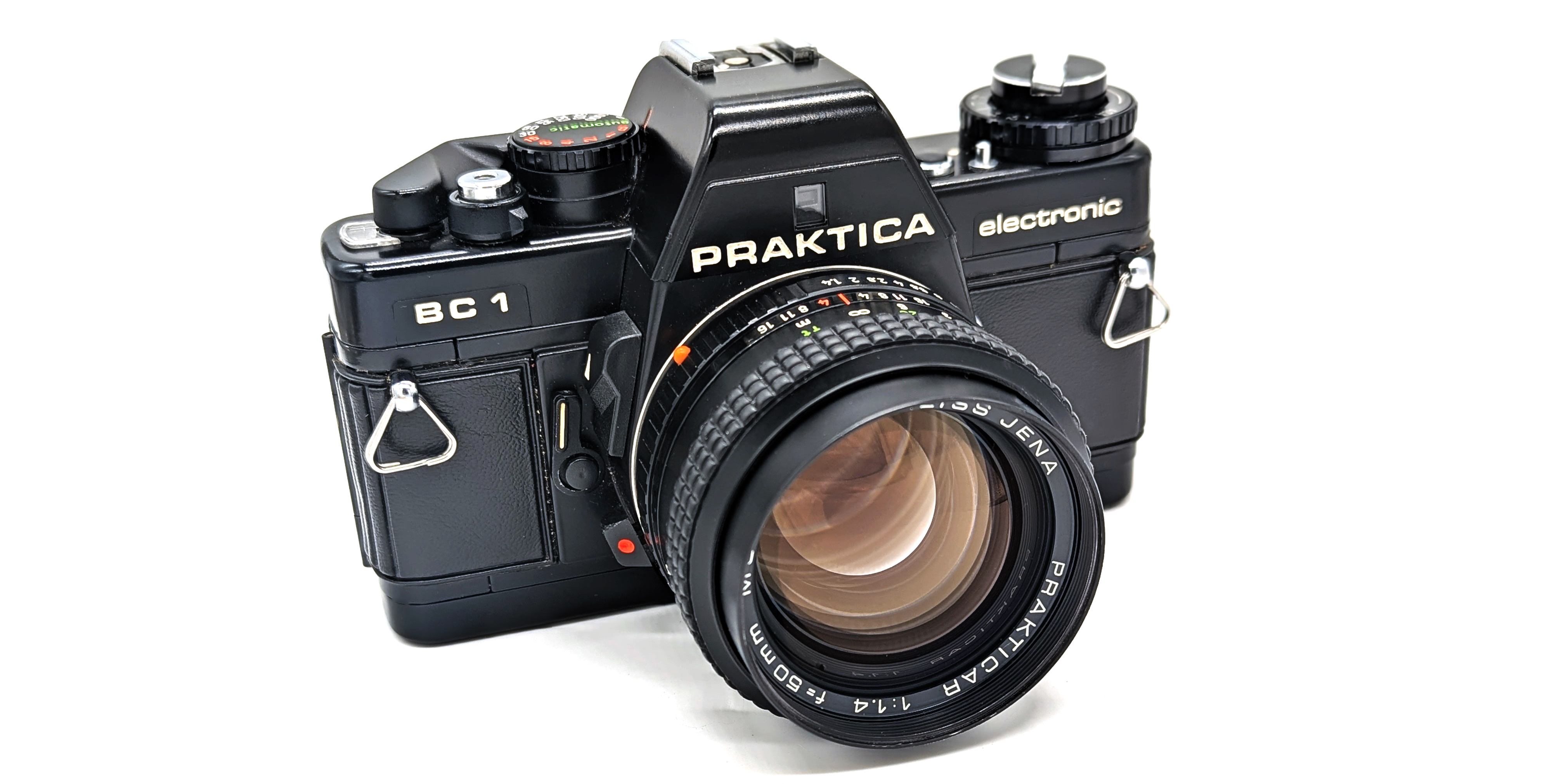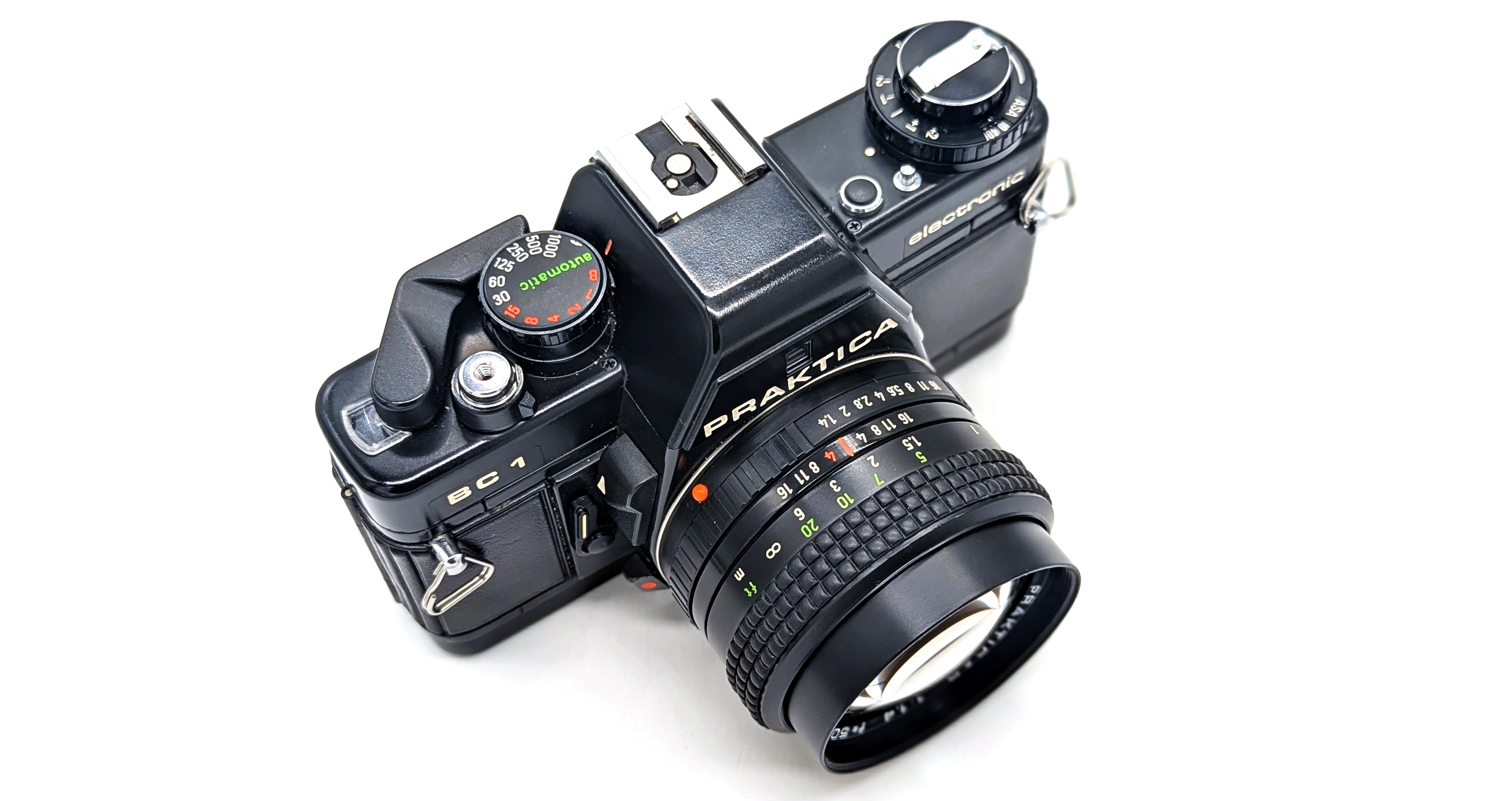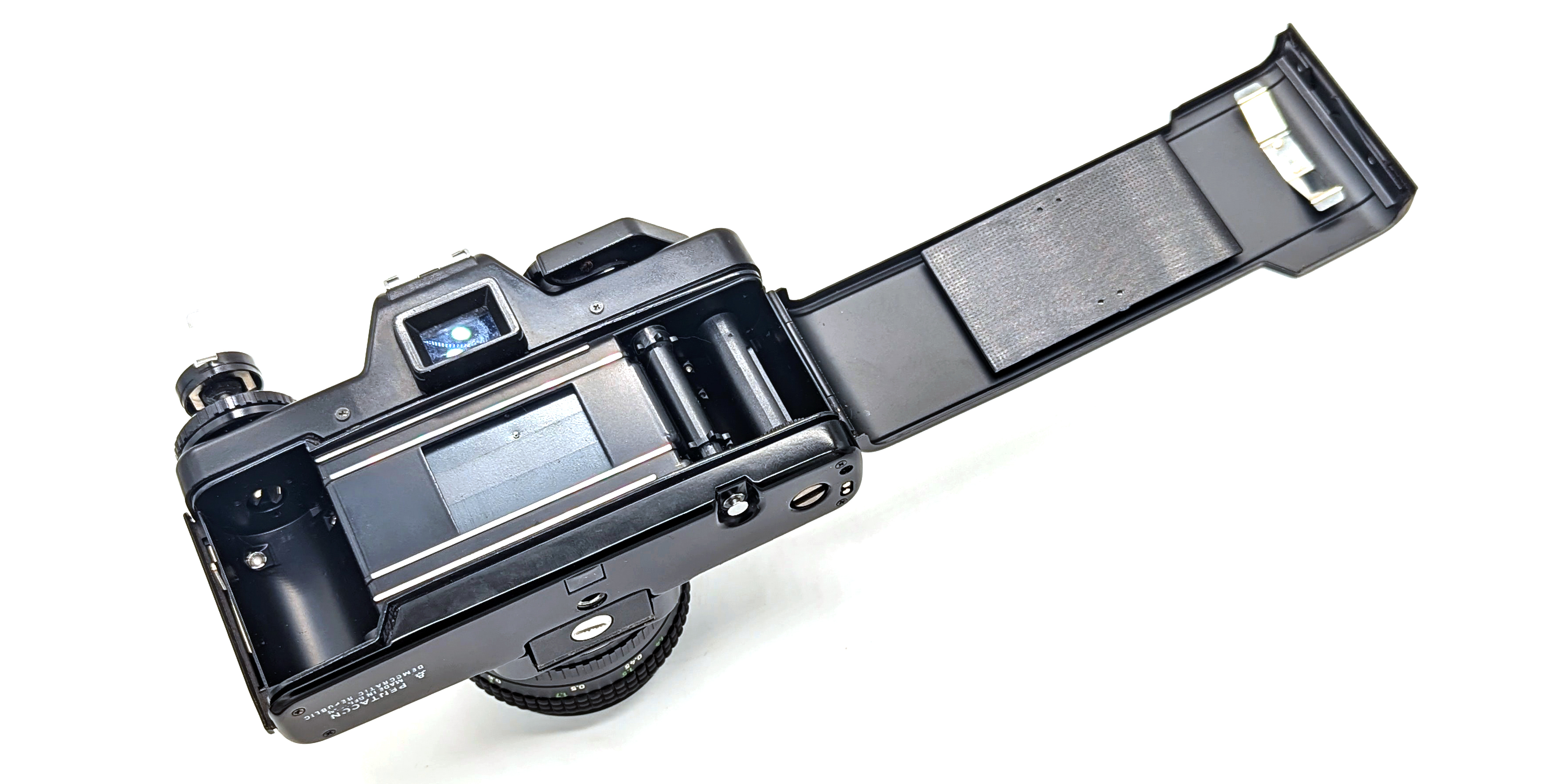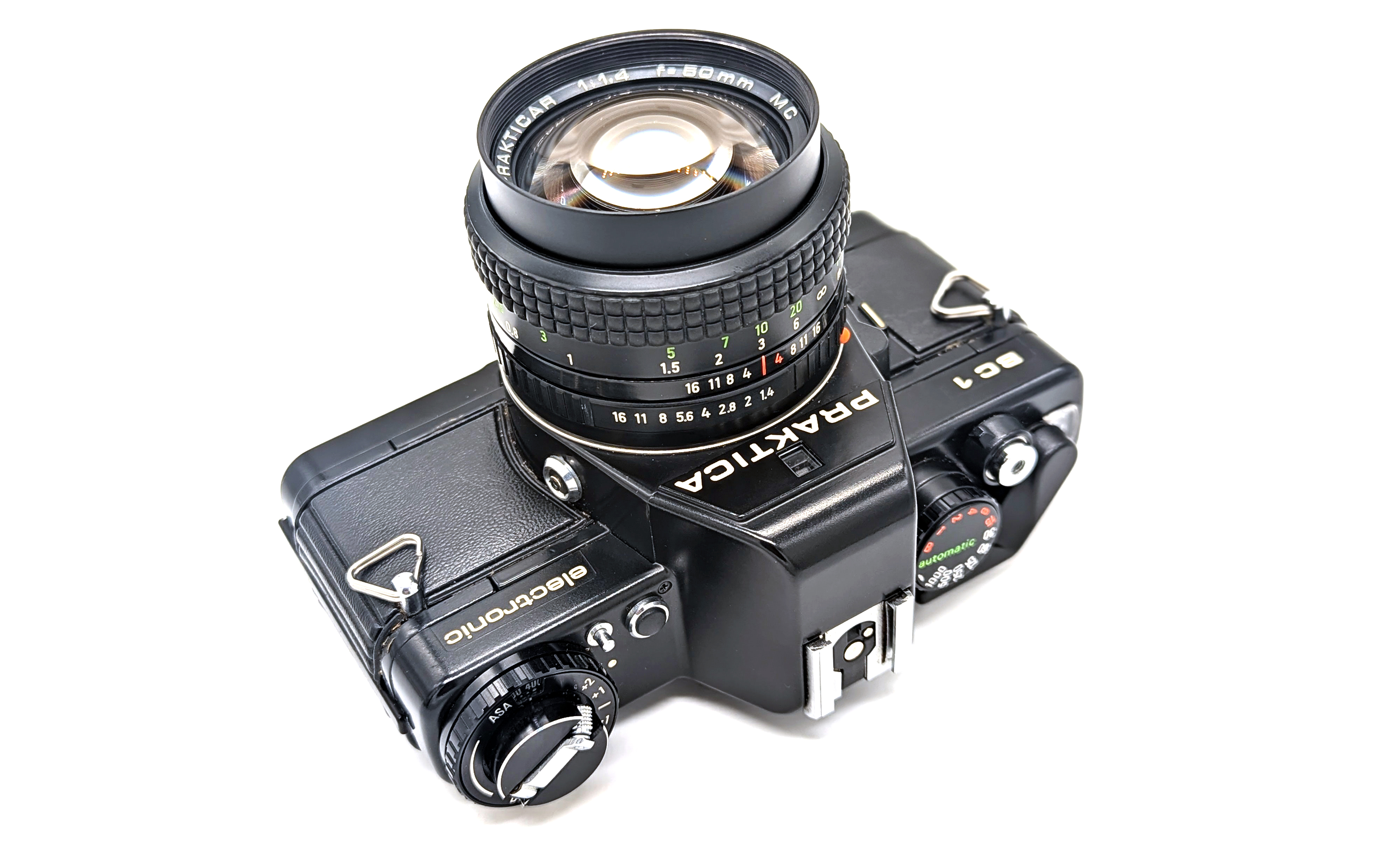
The 1984 East German Praktica BC-1 was a modest update of Pentacon’s 1979 flagship B200 35mm SLR. The BC-1 also appeared as the “Jenaflex AM-1” and the “Praktica BC-3” (the latter being export versions). While nothing particularly special or innovative for the mid-1980s, the BC-1’s main appeal, as with the rest of the “PB” (Praktica Bayonet) line of cameras, is as a platform for the last generation of Carl Zeiss Jena and Pentacon 35mm SLR lenses. Because we covered some background of the Praktica bayonet cameras and lenses in the review of the 1987 BX20, here we are just going to focus on the BC-1.
Along with all other major manufacturers of M42 bodies and lenses during the late 1970s, Praktica followed suit and switched from M42 to a proprietary bayonet mount and electronically-controlled shutters for aperture-priority autoexposure operation. Starting in 1979, three “lines” of lenses were made for the PB system: (1) CZJ produced the “high end” primes and zoom, deploying a mix of repurposed M42 optics as well as some new designs; (2) Pentacon produced a few prime lenses in house, mostly M42 carryovers; and (3) Japan-based companies like Sigma and Tokina produced a few primes and a few ho-hum, slowish zooms. It appears that after 1983-84, CZJ lens production for the system fell to a trickle. After Pentacon was split up and sold, Schneider briefly resurrected the BX20 as the moderately-redesigned “BX20s” in 1992, but by that time there were no German-designed lenses made for it except for the kit Pentacon 50mm f/1.8.
While the 1979 Praktica B200 (and its export version, the “BC-X”) was a fairly competitive body at the time for the mid-range, non-professional SLR class, the 1984 BC-1 was just a slight refresh with no real additional features other than the addition of a flash ready light. With an all metal body, BC-1 is certainly a quality manual focus SLR whose only real limitation is its par-for-the-course 1/1000 top shutter speed. Praktica produced a fair number of them (along the AM-1 and BC-3), and they are plentiful and cheap on the used market (with the vast majority being in Europe). Let’s take a look.
Specifications
| Shutter | Electronic Metal Vertical |
| Shutter Speeds | 40 secs – 1/1000 (stepless) |
| ASA Range | 12-3200 |
| Focusing Screen | Fresnel + Triple Wedge + Microprism |
| Flash Sync | 1/90 |
| Viewfinder Coverage | 95% |
| Weight (Body) | 530g |
| Battery | 1 x 6V (A544 Akaline / S28PX Silver Oxide) |
| Exposure Lock? | Yes |
| Self-Timer? | Yes |
| Exposure Compensation? | Yes |
| Motor Drive Capable? | Yes |

Operation
Viewfinder/Focusing Screen: The BC-1 has a relatively nice focusing screen with three focus aids, 95% coverage, and good viewfinder brightness for this class of camera. The viewfinder displays the selected aperture at the bottom of the view using a mechanical system that links to the lens. On the right, a series of red-dot LEDs to the left side of the shutter speeds will appear. In autoexposure mode, a half-depress of the button will light up the LED next to the camera’s preferred shutter speed. In metered manual mode, the red LED will light up next to the shutter speed that should be selected for the aperture chosen on the lens. Easy and straightforward stuff.
Exposure Lock: Unlike many cameras in this class from other manufacturers, the BC-1 has a useful exposure lock button located on the top of the body. To use it, continue half-pressing the shutter button and then press the exposure lock button. As long as the shutter button is half-pressed, the exposure will be locked. When the shutter button is released, the lock disengages.
Flash: A “new” feature on the BC-1 was an extra flash shoe pin that would provide a flash charge indication in the viewfinder and adjust the shutter speed automatically to 1/90. This only works with certain Praktica-branded flashes (which were seemingly all made under contract in Japan). With any other type of flash, one must set the shutter speed dial to the “flash” setting.
Battery: Along with all other PB cameras, the BC-1 originally used a PX28, a 6V mercury battery. The Germans must have had a soft spot for this kind of battery as it was also used by the contemporary West German Contax RTS II. Fortunately, there are perfect modern replacements like A544 (alkaline), S28PX (silver oxide), a 6V lithium (I have not tried this one), or stacking four LR44s or SR44s. Plenty of options. Silver oxide is my preferred route.
Shutter: The electronically-controlled vertical metal shutter is not particularly quiet but has proven to be fairly robust in the 40 years since its production.
Other Features: The BC-1 also has the stable of standard other features one would expect from this class of camera, including an exposure compensation dial, an external depth of field preview lever, a self-timer, and a battery check button.

Accessories
B Winder: The B winder is a simple device that screws into the bottom of the camera and takes 4 x AA batteries. It is not particularly fast with “up to” two frames per second and is quite loud.
M42 Lens Adapter: Praktica made the only adapter of which I am aware that that permits the use of M42 lenses (in stop down mode only) on PB bodies. This slightly rare adapter has the required three electronic contacts that communicate with the body that a lens is attached. Because PB bodies require that contact must be made with the three connectors on the body for the metering system to work, no lenses other than M42 with the Praktica adapter (and those lenses that can adapt to M42) can be used on them.
Flashes: The BC-1’s only real “new” feature over the B200 series was a flash “ready light” that appeared in the viewfinder. This function only works with a few contemporary Praktica-branded flash units (these flashes were made in Japan) like the BC1600, BC2400, BD24, BD32, and BD36. Praktica-branded flashes are an enigma, with seemingly few popping up for sale in Europe. The later BX20 and BX20s were TTL-flash capable, using Olympus’ system.
Miscellaneous: Other than a case, the BC-1 could utilize a variety of other Praktica accessories such as an eye cup, an angle finder, bellows, extension tubes, and teleconverters.

Longevity Issues
Other than the types of general faults that may plague many electronic 35mm SLRs from the 1970s and 1980s, like frame counters failing and electronics burning out, the BC-1 appears to have been a fairly robust platform as long as it was taken care of. A common complaint is that the shutter speed dial plate falls off because of the failure of the factory adhesive. Also, if you find that with a good battery, the autoexposure is flashing “under” no matter what you do, remove the four bottom screws from the baseplate and press the white electronics terminal with your finger to see if the autoexposure then works. If this is the issue, for a decent workaround, shove some cardboard between the connector and the base plate to keep some pressure on the former and reassemble. As with nearly all old cameras, it remains important to run test rolls through any PB body as an electronic shutter can fail in ways that would not be immediately noticeable until you develop the negatives.
Conclusion
Although Praktica PB bodies as a whole were and are not that exciting, the ability to use some unique, high-end, extremely expensive for the time that noticeably stand apart from the manual focus Nikons, Canons, and Minoltas of the era, would be the main draw. in my opinion, the PB cameras are a much better platform for CZJ and Pentacon 35mm SLR lenses than any older Praktica M42 body. The BC-1’s viewfinder is nice, the autoexposure operates as intended, and the exposure lock is very useful. The only advantages of the later BX20 are its lighter weight and capability for TTL flash, although some anecdotal reports are that the BX20 may not be as reliable in the long-term as the B200/BC-1 series. My impression is that the B200 / BC-1 / BX20 series are probably equally reliable. Be sure to TEST all functions with any Praktica PB body that that you are considering acquiring.